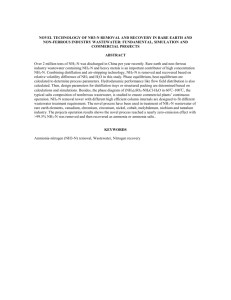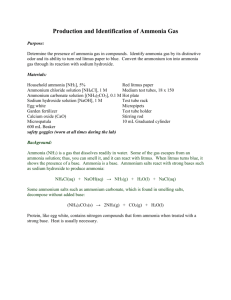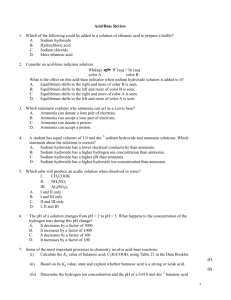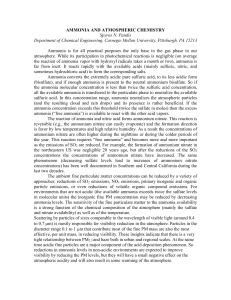Standard Methods for the Examination of Water and Wastewater
advertisement
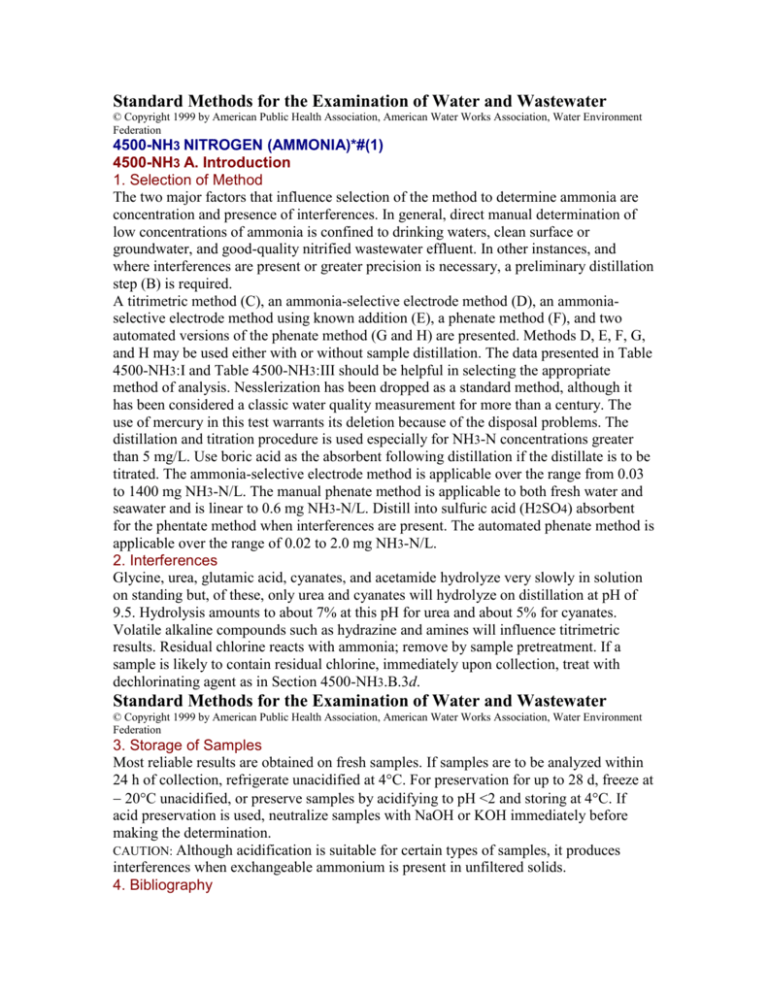
Standard Methods for the Examination of Water and Wastewater © Copyright 1999 by American Public Health Association, American Water Works Association, Water Environment Federation 4500-NH3 NITROGEN (AMMONIA)*#(1) 4500-NH3 A. Introduction 1. Selection of Method The two major factors that influence selection of the method to determine ammonia are concentration and presence of interferences. In general, direct manual determination of low concentrations of ammonia is confined to drinking waters, clean surface or groundwater, and good-quality nitrified wastewater effluent. In other instances, and where interferences are present or greater precision is necessary, a preliminary distillation step (B) is required. A titrimetric method (C), an ammonia-selective electrode method (D), an ammoniaselective electrode method using known addition (E), a phenate method (F), and two automated versions of the phenate method (G and H) are presented. Methods D, E, F, G, and H may be used either with or without sample distillation. The data presented in Table 4500-NH3:I and Table 4500-NH3:III should be helpful in selecting the appropriate method of analysis. Nesslerization has been dropped as a standard method, although it has been considered a classic water quality measurement for more than a century. The use of mercury in this test warrants its deletion because of the disposal problems. The distillation and titration procedure is used especially for NH3-N concentrations greater than 5 mg/L. Use boric acid as the absorbent following distillation if the distillate is to be titrated. The ammonia-selective electrode method is applicable over the range from 0.03 to 1400 mg NH3-N/L. The manual phenate method is applicable to both fresh water and seawater and is linear to 0.6 mg NH3-N/L. Distill into sulfuric acid (H2SO4) absorbent for the phentate method when interferences are present. The automated phenate method is applicable over the range of 0.02 to 2.0 mg NH3-N/L. 2. Interferences Glycine, urea, glutamic acid, cyanates, and acetamide hydrolyze very slowly in solution on standing but, of these, only urea and cyanates will hydrolyze on distillation at pH of 9.5. Hydrolysis amounts to about 7% at this pH for urea and about 5% for cyanates. Volatile alkaline compounds such as hydrazine and amines will influence titrimetric results. Residual chlorine reacts with ammonia; remove by sample pretreatment. If a sample is likely to contain residual chlorine, immediately upon collection, treat with dechlorinating agent as in Section 4500-NH3.B.3d. Standard Methods for the Examination of Water and Wastewater © Copyright 1999 by American Public Health Association, American Water Works Association, Water Environment Federation 3. Storage of Samples Most reliable results are obtained on fresh samples. If samples are to be analyzed within 24 h of collection, refrigerate unacidified at 4°C. For preservation for up to 28 d, freeze at 20°C unacidified, or preserve samples by acidifying to pH <2 and storing at 4°C. If acid preservation is used, neutralize samples with NaOH or KOH immediately before making the determination. CAUTION: Although acidification is suitable for certain types of samples, it produces interferences when exchangeable ammonium is present in unfiltered solids. 4. Bibliography THAYER, G.W. 1970. Comparison of two storage methods for the analysis of nitrogen and phosphorus fractions in estuarine water. Chesapeake Sci. 11:155. SALLEY, B.A., J.G. BRADSHAW & B.J. NEILSON. 1986. Results of Comparative Studies of Presevation Techniques for Nutrient Analysis on Water Samples. Virginia Institute of Marine Science, Gloucester Point. 4500-NH3 F. Phenate Method (Monroe’s alternative micro-procedure) 1. General Discussion a. Principle: An intensely blue compound, indophenol, is formed by the reaction of ammonia, hypochlorite, and phenol catalyzed by sodium nitroprusside. b. Interferences: Complexing magnesium and calcium with citrate eliminates interference produced by precipitation of these ions at high pH. There is no interference from other trivalent forms of nitrogen. Remove interfering turbidity by distillation or filtration. If hydrogen sulfide is present, remove by acidifying samples to pH 3 with dilute HCl and aerating vigorously until sulfide odor no longer can be detected. 2. Apparatus Spectrophotometer for use at 640 nm with a light path of 1 cm or greater. 3. Reagents a. Phenol solution: Mix 1.11 mL liquified phenol (89%) with 95% v/v ethyl alcohol to a final volume of 10 mL. Prepare weekly. CAUTION: Wear gloves and eye protection when handling phenol; use good ventilation to minimize all personnel exposure to this toxic volatile substance. (40 L/sample therefore 250 samples) b. Sodium nitroprusside, 0.5% w/v: Dissolve 50 mg sodium nitroprusside in 10 mL deionized water. Store in amber bottle for up to 1 month. . (40 L/sample therefore 250 samples) c. Alkaline citrate: Dissolve 20 g trisodium citrate and 1 g sodium hydroxide in deionized water. Dilute to 100 mL. Standard Methods for the Examination of Water and Wastewater © Copyright 1999 by American Public Health Association, American Water Works Association, Water Environment Federation d. Sodium hypochlorite, commercial solution, about 5%. This solution slowly decomposes once the seal on the bottle cap is broken. Replace about every 2 months. e. Oxidizing solution: Mix 2 mL alkaline citrate solution with 0.5 mL sodium hypochlorite. (100 L/sample therefore 25 samples) Prepare fresh daily. f. Stock ammonium solution: See Section 4500-NH3.D.3d. g. Standard ammonium solution: Use stock ammonium solution and water to prepare a calibration curve in a range appropriate for the concentrations of the samples. 4. Procedure To a 1-mL sample in a 5-mL cuvette, add, with thorough mixing (using pipette) after each addition, 40 L phenol solution, 40 L sodium nitroprusside solution, and 100 L oxidizing solution. Cover samples with plastic wrap or paraffin wrapper film. Let color develop at room temperature (22 to 27°C) in subdued light for at least 1 h. Color is stable for 24 h. Measure absorbance at 640 nm. Prepare a blank and at least two other standards by diluting stock ammonia solution into the sample concentration range. Treat standards the same as samples. 5. Calculations Prepare a standard curve by plotting absorbance readings of standards against ammonia concentrations of standards. Compute sample concentration by comparing sample absorbance with the standard curve. 6. Precision and Bias For the manual phenate method, reagent water solutions of ammonium sulfate were prepared and analyzed by two analysts in each of three laboratories. Results are summarized in Table 4500-NH3:III. 7. Bibliography SOLORZANO, L. 1969. Determination of ammonia in natural waters by the phenolhypochlorite method. Limnol. Oceanogr. 14:799. PARSONS, T.R., Y. MAITA & C.M. LALLI. 1984. A Manual of Chemical and Biological Methods for Seawater Analysis. Pergamon Press, Elmsford, N.Y. Standard Methods for the Examination of Water and Wastewater © Copyright 1999 by American Public Health Association, American Water Works Association, Water Environment Federation Endnotes 1 (Popup - Footnote) * APPROVED BY STANDARD METHODS COMMITTEE, 1997.

